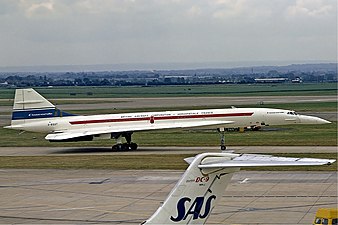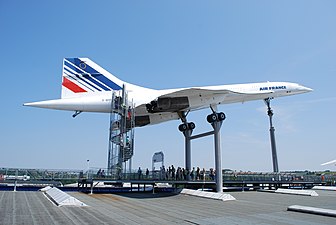|
Drag (physics)
In fluid dynamics, drag, sometimes referred to as fluid resistance, is a force acting opposite to the relative motion of any object moving with respect to a surrounding fluid.[1] This can exist between two fluid layers, two solid surfaces, or between a fluid and a solid surface. Drag forces tend to decrease fluid velocity relative to the solid object in the fluid's path. Unlike other resistive forces, drag force depends on velocity.[2][3] Drag force is proportional to the relative velocity for low-speed flow and is proportional to the velocity squared for high-speed flow. This distinction between low and high-speed flow is measured by the Reynolds number. ExamplesExamples of drag include:
TypesThere are many distinct types of drag caused by different physical interactions between the object and fluid. Two types of drag are relevant for all objects:
There are two types of which are primarily relevant for aircraft:
Wave resistance affects watercraft:
Last, in aerodynamics the term "parasitic drag" is often used. Parasitic drag is the sum of form drag and skin friction drag and is entirely negative to an aircraft, in contrast with lift-induced drag which is a consequence of generating lift. Comparison of form drag and skin friction
The effect of streamlining on the relative proportions of skin friction and form drag is shown in the table at right for an airfoil, which is a streamlined body, and a cylinder, which is a bluff body. Also shown is a flat plate in two different orientations, illustrating the effect of orientation on the relative proportions of skin friction and form drag, and showing the pressure difference between front and back. A body is known as bluff or blunt when the source of drag is dominated by pressure forces, and streamlined if the drag is dominated by viscous forces. For example, road vehicles are bluff bodies.[9] For aircraft, pressure and friction drag are included in the definition of parasitic drag. Parasite drag is often expressed in terms of a hypothetical. Lift-induced dragLift-induced drag (also called induced drag) is drag which occurs as the result of the creation of lift on a three-dimensional lifting body, such as the wing or propeller of an airplane. Induced drag consists primarily of two components: drag due to the creation of trailing vortices (vortex drag); and the presence of additional viscous drag (lift-induced viscous drag) that is not present when lift is zero. The trailing vortices in the flow-field, present in the wake of a lifting body, derive from the turbulent mixing of air from above and below the body which flows in slightly different directions as a consequence of creation of lift. With other parameters remaining the same, as the lift generated by a body increases, so does the lift-induced drag. This means that as the wing's angle of attack increases (up to a maximum called the stalling angle), the lift coefficient also increases, and so too does the lift-induced drag. At the onset of stall, lift is abruptly decreased, as is lift-induced drag, but viscous pressure drag, a component of parasite drag, increases due to the formation of turbulent unattached flow in the wake behind the body. Parasitic dragParasitic drag, or profile drag, is the sum of viscous pressure drag (form drag) and drag due to surface roughness (skin friction drag). Additionally, the presence of multiple bodies in relative proximity may incur so called interference drag, which is sometimes described as a component of parasitic drag. In aeronautics the parasitic drag and lift-induced drag are often given separately. For an aircraft at low speed, induced drag tends to be relatively greater than parasitic drag because a high angle of attack is required to maintain lift, increasing induced drag. As speed increases, the angle of attack is reduced and the induced drag decreases. Parasitic drag, however, increases because the fluid is flowing more quickly around protruding objects increasing friction or drag. At even higher speeds (transonic), wave drag enters the picture. Each of these forms of drag changes in proportion to the others based on speed. The combined overall drag curve therefore shows a minimum at some airspeed - an aircraft flying at this speed will be at or close to its optimal efficiency. Pilots will use this speed to maximize endurance (minimum fuel consumption), or maximize gliding range in the event of an engine failure. The equivalent parasite area is the area which a flat plate perpendicular to the flow would have to match the parasite drag of an aircraft. It is a measure used when comparing the drag of different aircraft. For example, the Douglas DC-3 has an equivalent parasite area of 2.20 m2 (23.7 sq ft) and the McDonnell Douglas DC-9, with 30 years of advancement in aircraft design, an area of 1.91 m2 (20.6 sq ft) although it carried five times as many passengers.[10]
The drag equation Drag depends on the properties of the fluid and on the size, shape, and speed of the object. One way to express this is by means of the drag equation: where
The drag coefficient depends on the shape of the object and on the Reynolds number where
At low , is asymptotically proportional to , which means that the drag is linearly proportional to the speed, i.e. the drag force on a small sphere moving through a viscous fluid is given by the Stokes Law: At high , is more or less constant, but drag will vary as the square of the speed varies. The graph to the right shows how varies with for the case of a sphere. Since the power needed to overcome the drag force is the product of the force times speed, the power needed to overcome drag will vary as the square of the speed at low Reynolds numbers, and as the cube of the speed at high numbers. It can be demonstrated that drag force can be expressed as a function of a dimensionless number, which is dimensionally identical to the Bejan number.[12] Consequently, drag force and drag coefficient can be a function of Bejan number. In fact, from the expression of drag force it has been obtained: and consequently allows expressing the drag coefficient as a function of Bejan number and the ratio between wet area and front area :[12] where is the Reynolds number related to fluid path length L. At high velocityAs mentioned, the drag equation with a constant drag coefficient gives the force moving through fluid a relatively large velocity, i.e. high Reynolds number, Re > ~1000. This is also called quadratic drag. The derivation of this equation is presented at Drag equation § Derivation. The reference area A is often the orthographic projection of the object, or the frontal area, on a plane perpendicular to the direction of motion. For objects with a simple shape, such as a sphere, this is the cross sectional area. Sometimes a body is a composite of different parts, each with a different reference area (drag coefficient corresponding to each of those different areas must be determined). In the case of a wing, the reference areas are the same, and the drag force is in the same ratio as the lift force.[13] Therefore, the reference for a wing is often the lifting area, sometimes referred to as "wing area" rather than the frontal area.[14] For an object with a smooth surface, and non-fixed separation points (like a sphere or circular cylinder), the drag coefficient may vary with Reynolds number Re, up to extremely high values (Re of the order 107).[15] [16] For an object with well-defined fixed separation points, like a circular disk with its plane normal to the flow direction, the drag coefficient is constant for Re > 3,500.[16] The further the drag coefficient Cd is, in general, a function of the orientation of the flow with respect to the object (apart from symmetrical objects like a sphere). PowerUnder the assumption that the fluid is not moving relative to the currently used reference system, the power required to overcome the aerodynamic drag is given by: The power needed to push an object through a fluid increases as the cube of the velocity increases. For example, a car cruising on a highway at 50 mph (80 km/h) may require only 10 horsepower (7.5 kW) to overcome aerodynamic drag, but that same car at 100 mph (160 km/h) requires 80 hp (60 kW).[17] With a doubling of speeds, the drag/force quadruples per the formula. Exerting 4 times the force over a fixed distance produces 4 times as much work. At twice the speed, the work (resulting in displacement over a fixed distance) is done twice as fast. Since power is the rate of doing work, 4 times the work done in half the time requires 8 times the power. When the fluid is moving relative to the reference system, for example, a car driving into headwind, the power required to overcome the aerodynamic drag is given by the following formula: Where is the wind speed and is the object speed (both relative to ground). Velocity of a falling object Velocity as a function of time for an object falling through a non-dense medium, and released at zero relative-velocity v = 0 at time t = 0, is roughly given by a function involving a hyperbolic tangent (tanh): The hyperbolic tangent has a limit value of one, for large time t. In other words, velocity asymptotically approaches a maximum value called the terminal velocity vt: For an object falling and released at relative-velocity v = vi at time t = 0, with vi < vt, is also defined in terms of the hyperbolic tangent function: For vi > vt, the velocity function is defined in terms of the hyperbolic cotangent function: The hyperbolic cotangent also has a limit value of one, for large time t. Velocity asymptotically tends to the terminal velocity vt, strictly from above vt. For vi = vt, the velocity is constant: These functions are defined by the solution of the following differential equation: Or, more generically (where F(v) are the forces acting on the object beyond drag): For a potato-shaped object of average diameter d and of density ρobj, terminal velocity is about For objects of water-like density (raindrops, hail, live objects—mammals, birds, insects, etc.) falling in air near Earth's surface at sea level, the terminal velocity is roughly equal to with d in metre and vt in m/s. For example, for a human body ( ≈0.6 m) ≈70 m/s, for a small animal like a cat ( ≈0.2 m) ≈40 m/s, for a small bird ( ≈0.05 m) ≈20 m/s, for an insect ( ≈0.01 m) ≈9 m/s, and so on. Terminal velocity for very small objects (pollen, etc.) at low Reynolds numbers is determined by Stokes law. In short, terminal velocity is higher for larger creatures, and thus potentially more deadly. A creature such as a mouse falling at its terminal velocity is much more likely to survive impact with the ground than a human falling at its terminal velocity.[18] Low Reynolds numbers: Stokes' drag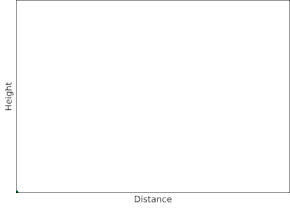 The equation for viscous resistance or linear drag is appropriate for objects or particles moving through a fluid at relatively slow speeds (assuming there is no turbulence). Purely laminar flow only exists up to Re = 0.1 under this definition. In this case, the force of drag is approximately proportional to velocity. The equation for viscous resistance is:[19]
where:
When an object falls from rest, its velocity will be where:
The velocity asymptotically approaches the terminal velocity . For a given , denser objects fall more quickly. For the special case of small spherical objects moving slowly through a viscous fluid (and thus at small Reynolds number), George Gabriel Stokes derived an expression for the drag constant: where is the Stokes radius of the particle, and is the fluid viscosity. The resulting expression for the drag is known as Stokes' drag:[20] For example, consider a small sphere with radius = 0.5 micrometre (diameter = 1.0 μm) moving through water at a velocity of 10 μm/s. Using 10−3 Pa·s as the dynamic viscosity of water in SI units, we find a drag force of 0.09 pN. This is about the drag force that a bacterium experiences as it swims through water. The drag coefficient of a sphere can be determined for the general case of a laminar flow with Reynolds numbers less than using the following formula:[21]
For Reynolds numbers less than 1, Stokes' law applies and the drag coefficient approaches ! AerodynamicsIn aerodynamics, aerodynamic drag, also known as air resistance, is the fluid drag force that acts on any moving solid body in the direction of the air's freestream flow.[22]
Alternatively, calculated from the flow field perspective (far-field approach), the drag force results from three natural phenomena: shock waves, vortex sheet, and viscosity. Overview of aerodynamicsWhen the airplane produces lift, another drag component results. Induced drag, symbolized , is due to a modification of the pressure distribution due to the trailing vortex system that accompanies the lift production. An alternative perspective on lift and drag is gained from considering the change of momentum of the airflow. The wing intercepts the airflow and forces the flow to move downward. This results in an equal and opposite force acting upward on the wing which is the lift force. The change of momentum of the airflow downward results in a reduction of the rearward momentum of the flow which is the result of a force acting forward on the airflow and applied by the wing to the air flow; an equal but opposite force acts on the wing rearward which is the induced drag. Another drag component, namely wave drag, , results from shock waves in transonic and supersonic flight speeds. The shock waves induce changes in the boundary layer and pressure distribution over the body surface. Therefore, there are three ways of categorizing drag.[23]: 19
The pressure distribution acting on a body's surface exerts normal forces on the body. Those forces can be added together and the component of that force that acts downstream represents the drag force, . The nature of these normal forces combines shock wave effects, vortex system generation effects, and wake viscous mechanisms. Viscosity of the fluid has a major effect on drag. In the absence of viscosity, the pressure forces acting to hinder the vehicle are canceled by a pressure force further aft that acts to push the vehicle forward; this is called pressure recovery and the result is that the drag is zero. That is to say, the work the body does on the airflow is reversible and is recovered as there are no frictional effects to convert the flow energy into heat. Pressure recovery acts even in the case of viscous flow. Viscosity, however results in pressure drag and it is the dominant component of drag in the case of vehicles with regions of separated flow, in which the pressure recovery is infective. The friction drag force, which is a tangential force on the aircraft surface, depends substantially on boundary layer configuration and viscosity. The net friction drag, , is calculated as the downstream projection of the viscous forces evaluated over the body's surface. The sum of friction drag and pressure (form) drag is called viscous drag. This drag component is due to viscosity. HistoryThe idea that a moving body passing through air or another fluid encounters resistance had been known since the time of Aristotle. According to Mervyn O'Gorman, this was named "drag" by Archibald Reith Low.[24] Louis Charles Breguet's paper of 1922 began efforts to reduce drag by streamlining.[25] Breguet went on to put his ideas into practice by designing several record-breaking aircraft in the 1920s and 1930s. Ludwig Prandtl's boundary layer theory in the 1920s provided the impetus to minimise skin friction. A further major call for streamlining was made by Sir Melvill Jones who provided the theoretical concepts to demonstrate emphatically the importance of streamlining in aircraft design.[26][27][28] In 1929 his paper 'The Streamline Airplane' presented to the Royal Aeronautical Society was seminal. He proposed an ideal aircraft that would have minimal drag which led to the concepts of a 'clean' monoplane and retractable undercarriage. The aspect of Jones's paper that most shocked the designers of the time was his plot of the horse power required versus velocity, for an actual and an ideal plane. By looking at a data point for a given aircraft and extrapolating it horizontally to the ideal curve, the velocity gain for the same power can be seen. When Jones finished his presentation, a member of the audience described the results as being of the same level of importance as the Carnot cycle in thermodynamics.[25][26] Power curve in aviation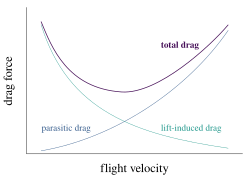 The interaction of parasitic and induced drag vs. airspeed can be plotted as a characteristic curve, illustrated here. In aviation, this is often referred to as the power curve, and is important to pilots because it shows that, below a certain airspeed, maintaining airspeed counterintuitively requires more thrust as speed decreases, rather than less. The consequences of being "behind the curve" in flight are important and are taught as part of pilot training. At the subsonic airspeeds where the "U" shape of this curve is significant, wave drag has not yet become a factor, and so it is not shown in the curve. Wave drag in transonic and supersonic flow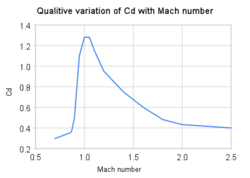 Wave drag, sometimes referred to as compressibility drag, is drag that is created when a body moves in a compressible fluid and at the speed that is close to the speed of sound in that fluid. In aerodynamics, wave drag consists of multiple components depending on the speed regime of the flight. In transonic flight, wave drag is the result of the formation of shockwaves in the fluid, formed when local areas of supersonic (Mach number greater than 1.0) flow are created. In practice, supersonic flow occurs on bodies traveling well below the speed of sound, as the local speed of air increases as it accelerates over the body to speeds above Mach 1.0. However, full supersonic flow over the vehicle will not develop until well past Mach 1.0. Aircraft flying at transonic speed often incur wave drag through the normal course of operation. In transonic flight, wave drag is commonly referred to as transonic compressibility drag. Transonic compressibility drag increases significantly as the speed of flight increases towards Mach 1.0, dominating other forms of drag at those speeds. In supersonic flight (Mach numbers greater than 1.0), wave drag is the result of shockwaves present in the fluid and attached to the body, typically oblique shockwaves formed at the leading and trailing edges of the body. In highly supersonic flows, or in bodies with turning angles sufficiently large, unattached shockwaves, or bow waves will instead form. Additionally, local areas of transonic flow behind the initial shockwave may occur at lower supersonic speeds, and can lead to the development of additional, smaller shockwaves present on the surfaces of other lifting bodies, similar to those found in transonic flows. In supersonic flow regimes, wave drag is commonly separated into two components, supersonic lift-dependent wave drag and supersonic volume-dependent wave drag. The closed form solution for the minimum wave drag of a body of revolution with a fixed length was found by Sears and Haack, and is known as the Sears-Haack Distribution. Similarly, for a fixed volume, the shape for minimum wave drag is the Von Karman Ogive. The Busemann biplane theoretical concept is not subject to wave drag when operated at its design speed, but is incapable of generating lift in this condition. d'Alembert's paradoxIn 1752 d'Alembert proved that potential flow, the 18th century state-of-the-art inviscid flow theory amenable to mathematical solutions, resulted in the prediction of zero drag. This was in contradiction with experimental evidence, and became known as d'Alembert's paradox. In the 19th century the Navier–Stokes equations for the description of viscous flow were developed by Saint-Venant, Navier and Stokes. Stokes derived the drag around a sphere at very low Reynolds numbers, the result of which is called Stokes' law.[29] In the limit of high Reynolds numbers, the Navier–Stokes equations approach the inviscid Euler equations, of which the potential-flow solutions considered by d'Alembert are solutions. However, all experiments at high Reynolds numbers showed there is drag. Attempts to construct inviscid steady flow solutions to the Euler equations, other than the potential flow solutions, did not result in realistic results.[29] The notion of boundary layers—introduced by Prandtl in 1904, founded on both theory and experiments—explained the causes of drag at high Reynolds numbers. The boundary layer is the thin layer of fluid close to the object's boundary, where viscous effects remain important even when the viscosity is very small (or equivalently the Reynolds number is very large).[29] See also
References
Bibliography
External links
|


